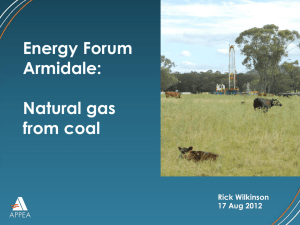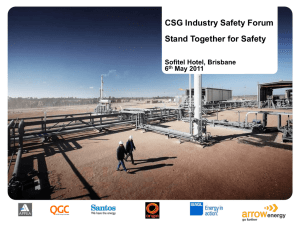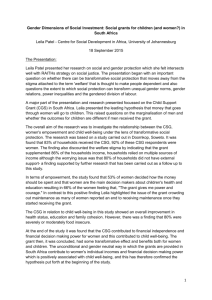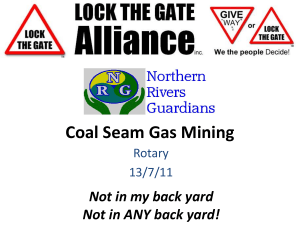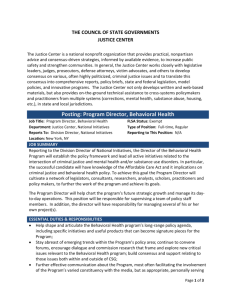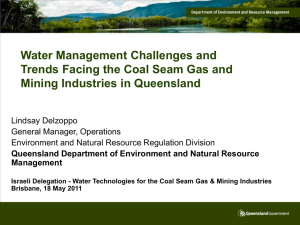Notes on Produced Water Caroline Graham, Rivers SOS For
advertisement
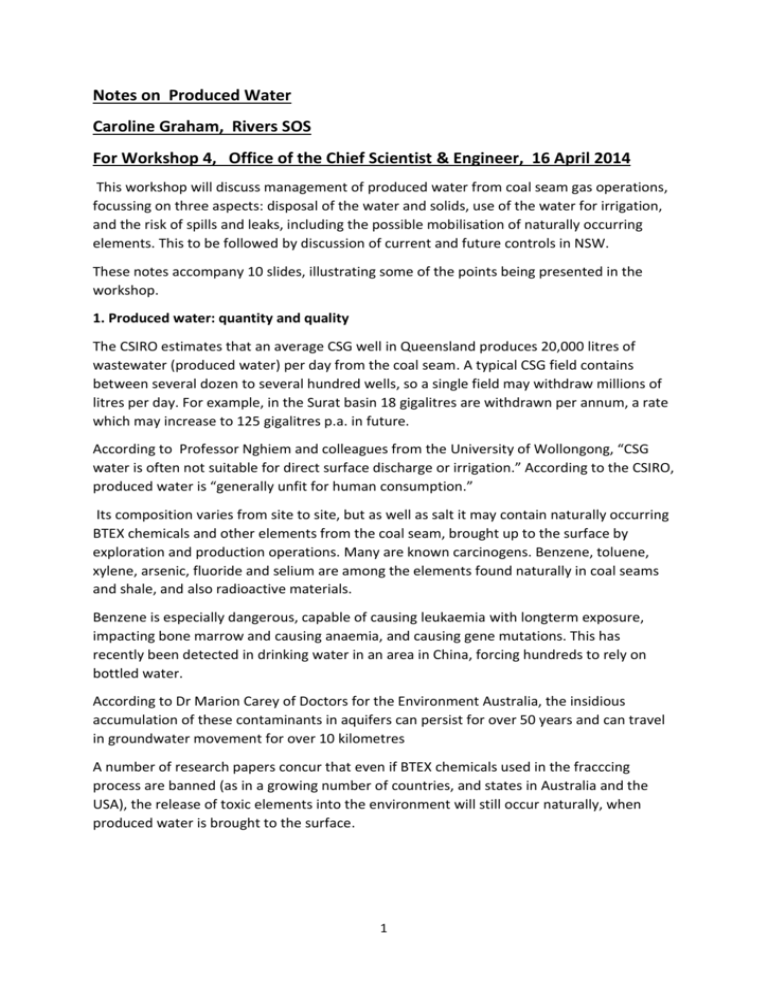
Notes on Produced Water Caroline Graham, Rivers SOS For Workshop 4, Office of the Chief Scientist & Engineer, 16 April 2014 This workshop will discuss management of produced water from coal seam gas operations, focussing on three aspects: disposal of the water and solids, use of the water for irrigation, and the risk of spills and leaks, including the possible mobilisation of naturally occurring elements. This to be followed by discussion of current and future controls in NSW. These notes accompany 10 slides, illustrating some of the points being presented in the workshop. 1. Produced water: quantity and quality The CSIRO estimates that an average CSG well in Queensland produces 20,000 litres of wastewater (produced water) per day from the coal seam. A typical CSG field contains between several dozen to several hundred wells, so a single field may withdraw millions of litres per day. For example, in the Surat basin 18 gigalitres are withdrawn per annum, a rate which may increase to 125 gigalitres p.a. in future. According to Professor Nghiem and colleagues from the University of Wollongong, “CSG water is often not suitable for direct surface discharge or irrigation.” According to the CSIRO, produced water is “generally unfit for human consumption.” Its composition varies from site to site, but as well as salt it may contain naturally occurring BTEX chemicals and other elements from the coal seam, brought up to the surface by exploration and production operations. Many are known carcinogens. Benzene, toluene, xylene, arsenic, fluoride and selium are among the elements found naturally in coal seams and shale, and also radioactive materials. Benzene is especially dangerous, capable of causing leukaemia with longterm exposure, impacting bone marrow and causing anaemia, and causing gene mutations. This has recently been detected in drinking water in an area in China, forcing hundreds to rely on bottled water. According to Dr Marion Carey of Doctors for the Environment Australia, the insidious accumulation of these contaminants in aquifers can persist for over 50 years and can travel in groundwater movement for over 10 kilometres A number of research papers concur that even if BTEX chemicals used in the fracccing process are banned (as in a growing number of countries, and states in Australia and the USA), the release of toxic elements into the environment will still occur naturally, when produced water is brought to the surface. 1 2. Disposal of produced water and solids Produced water contains not only salt and naturally occurring toxic elements, but it may also include fraccing chemicals if these were used in CSG operations. The produced water can be treated, usually by reverse osmosis (RO) – the only method in use in Australia at present. RO is not able to remove all the toxic chemicals but does remove salt. However the accumulation of mountains of salt, multiplying across Queensland and NSW, has created a currently insoluble disposal problem. Estimates of quantities of salt vary. Both Doctors for the Environment Australia and the Lock the Gate Alliance estimate that the amount of salt produced could be around 31 tonnes p.a. over the next 30 years. The Senate Inquiry into CSG estimated that the CSG industry would be producing 750,000 tonnes of salt p.a. The Williams report estimates that a well discharging 20,000 litres per day of saline water will produce around 100 kg of salt per day. No satisfactory means of disposal has been invented, yet the mountains of salt continue to pile up as the industry rapidly expands. The NSW Parliamentary Inquiry into CSG, after finding that there are no satisfactory solutions for salt disposal, recommended that “ the NSW Government not approve any coal seam gas activity without a solid waste management plan included in the relevant approval” (Recommendation 4.95, May 2012). But all methods of salt and produced water disposal have been tried and found wanting, as follows: Evaporation pools – simply channelling produced water into pools, lined or unlined, and reducing the quantity through evaporation. Flooding or leaking, as occurring in a few well-publicised events already, causes dispersal of saline and toxic water into the environment, and this risk led to the banning of this method, which also had no means of dealing with remnant salt. Evaporation pools were banned by the NSW Government in 2011. Re-injection, below the surface, into aquifers or abandoned mines. Origin Energy is trialling this method with treated water (leaving the problem of salt disposal) at Spring Gully’s Precipice Aquifer, and at Reedy Creek and Condabri at a cost of $117 million (Origin web site 2013). This appears to be a promising method, but still fraught with problems. The National Water Commission notes that there are risks involved in re-injecting water into aquifers even if the water has been treated. Injection can change the pressure within and between aquifers, especially where aquifers are connected (as in the case of parts of the Great Artesian Basin). There are issues of “geochemical incompatibility” (NWC Report No. 54, Sept. 2011). 2 In the USA 98% of the produced water is injected underground, mostly in wells drilled for this purpose near to the well/s in production. Numerous accidents have occurred, concerning wells exploding under pressure from the re-injection process, or breaches which accidentally connect aquifers, possibly degrading water quality. Release into streams and river systems. The release of salt and toxic chemicals with the produced water threatens freshwater ecological systems, and may result in uptake by stock and crops. In Queensland in 2010, treated produced water was allowed to be discharged into the Condamine River, at a rate of 20 megalitres per day. In 2011 it was found that this water contained boron and cadmium in excess of ANZECC guidelines, believed to be due to limitations in the reverse osmosis process. Release of high quality treated water can kill aquatic organisms, which are accustomed to very different water composition/quality. Dumping at sea. This simple method of disposal could be used for CSG water but is mostly ruled out by the industry as too costly. It is used to dispose of salt by BHP Billiton, after it is separated from coal wastewater at its RO plant at the Appin West Colliery. BHP Billiton dumps the salt in Allens Creek which takes it to the sea near Port Kembla, via trucks which have contributed to the notorious death rate on the Picton Road, which has been upgraded at great expense. BHP B’s coal mines, however, are only a short distance from the coast, whereas Santos (and no doubt other CSG producers) complains that from inland sites this disposal method would involve 200 tankers travelling for hundreds of kilometres for 24 hours a day – too expensive and too disruptive of traffic. Also large scale dumping at sea could be a threat to fisheries and marine ecology if widely adopted. “Beneficial use” in agriculture or industry. Industrial uses for produced water include recycling for use in drilling, for washing coal, for cooling power plants, or – as with AGL’s Camden project – for making bricks. However so far industrial uses like these are minimal in quantity and do not go far towards solving the massive disposal problem. Table salt, for instance, cannot be easily processed from this brine. Agricultural usage rules out the possibility of watering stock with produced water. It would need to be treated – in Pennsylvania cows who consumed untreated water had to be quarantined by the Department of Agriculture “to protect the public from consuming any of the potentially contaminated product … the main element of concern is the heavy metal strontium, which can be toxic to humans, especially in growing children.” But as noted, even treated water may contain toxic substances. 3 3. Use of produced water for irrigation By a process of elimination, this leaves irrigation of crops as possibly the most viable method of disposal. AGL is recently claiming that its trial near Gloucester is successful, and at Chinchilla, Metgasco’s publicity shows a farmer claiming that this is a “godsend.” A number of companies – Netafim, SunWater, etc. – are now offering to install irrigation systems for farmers or forestry plantations using produced water, either drip irrigation or sprinkler systems, and promising soil improvement as well as crop enhancement and shield from drought. (One Melbourne-based company, Creative Water Technology, claims that it can process all treated produced water including brine down to “Zero Liquid Discharge.” As there is then no brine to dispose of, they boast that there are “no environmental issues.” This company does not disclose its technology on its web site. Have their amazing claims been investigated ?) The current problems with irrigation usage are as follows: The most obvious and the most serious problem is that the life of any gas field is a few decades at best, and so the supply of produced water to farms or forest plantations is limited. The installation of expensive irrigation systems and extensive pipelines, not to mention RO plants, may not be a good investment. The Faustian bargain of successful cropping is being welcomed, but is not a long term solution. The next generation of farmers may be left with rusting and useless irrigation equipment, and dry land rendered permanently useless by saline residues, as well as other contaminants, on their once briefly fertile paddocks. The question of intergenerational equity looms large over this method, as with most others. The inevitable short term fate has not yet cast its shadow over farmer Ken Schmidt, as featured on Metgasco’s media release, 14 Feb., 2014. (It should be noted that although Schmidt was featured in Metgasco’s publicity to advertise the efficacy of irrigation with produced water, it is actually Queensland Gas‘s project). Farmer Schmidt’s previously marginal grazing land south of Chinchilla is now “prized agricultural land” capable of producing 10,000 tonnes of fodder crops per annum. The produced water is treated at a new RO plant near Chinchilla, and Schmidt hopes to use 16 megalitres per day for lucerne and other crops to sell to beef feedlots. Leaving aside the fact that RO does not remove all contaminants, the temporary nature of this “godsend” should be of concern. 100 megalitres per day of the treated water is also piped to Chinchilla Weir to supplement the town’s water supply. The pipelines will be obsolete in a few decades and the town’s water supply system will be back to square one. In NSW, Hunter Water and Mid Coast Water refuse to accept produced water supplements (I’m not sure about the position of the other 11 water supply systems; they are yet to be affected by CSG extraction). 4 On the subject of pipelines, there are said to be five million miles of ageing pipelines in the USA, involving several high profile accidents. Last year a gas pipeline in China exploded, injuring two and halting gas supplies (Reuters, May 26, 2013). The AGL Gloucester trial, on its Tiedmans property, involves irrigation of 140 hectares in a 2 year trial, using a blend of fresh water pumped from the Avon River with AGL’s produced water, at a rate of 3:1. Now over 65 tonnes of tricale have been harvested in bales and sold to local farmers as fodder, and AGL plans to expand this process, having purchased a further 1500 hectares of local land. It is said that there has also been soil improvement, however this would surely be due to the addition of compost, lime, gypsum and geolite to the soil, extraneous to produced water and irrigation (The Land, 26.12.13) AGL is not even treating this water, produced from its exploration wells. The company has not been required to list the full range of contaminants, whether “naturally occurring” or added through fraccing, or both. The NSW Office of Coal Seam Gas has approved AGL’s water management plan and there is no testing for a range of chemicals normally found in produced water: chromium, cyanide, uranium, radium, etc. Therefore the Groundswell Gloucester Group, opposed to CSG expansion, can claim that there is no evidence that heavy metals are not absorbed into AGL’s fodder crops, which are being sold for local dairy and beef cattle – a practice banned in the USA and New Zealand (ABC, Rural Report, 24.12.13). Groundswell Gloucester’s water resources engineer, Jeff Kite, was critical of AGL’s trial, saying “Unless the design of the program is substantially changed there will never be any worthwhile data or results … It is simply a program for disposing of produced water from AGL’s test wells” (Newcastle Herald, 9.4.2014). AGL’ s soil and crop advisor Fodder King stated that it could find “no adverse effects” in the soil although there was “a slight increase in salinity due to drier conditions.” Fodder King was pulled up by ASIC in March 2002 in order to protect investors because of “misleading and deceptive statements” in its prospectus, about its prospects and its ability to repay loans. Its credibility is therefore questionable. In contrast, Stuart Khan and Geena Kordek, researchers from the University of NSW, are concerned over the health of livestock due to irrigation with produced water, and wrote that “long term use of high salinity soils can disrupt the soil’s physical structure … limiting the agricultural suitability of impacted areas.” (CSG: Produced Water and Solids, Paper for OCSE, 22.11.2013). Macquarie University researchers Damien Gore and Peter Davies write, regarding irrigation, “the solutes in the produced water are left behind in the soil environment, where a small amount will be taken up by the crops” with the remainder seeping into streams or remaining in the soil. This may be environmentally damaging “with the aphorism ‘dilution is not the solution’ being appropriate …where produced water is used for irrigation there is a risk of the bio-accumulation of certain contaminants in 5 cereal crops and stock which may affect human health.” (Paper for OCSE, October 2013). The quarantine of cows in Pennsylvania after they drank produced water has been mentioned above. In New Zealand, in October 2013 - after the ban was imposed – 150,000 litres of milk were found to be contaminated with suspected mine waste. The company concerned, Fonterra, collects milk from the Taranaki dairy region, which uses produced water. In 2011, Patrick Neal, a member of the NSW Farmers’ Association’s Dairy Committee, told the NSW Parliamentary Inquiry into CSG that if the heavy metals from produced water are taken up by grass and then ingested by cows, or if the metals contaminate drinking water, then “a lot of the farms will become unviable.” Dairy Australia imposes controls over animal fodder, and farmers are obliged to declare sources of fodder and any chemicals used in its production. Beef producer Swin Hudson from Tremere-Hidden Valley had to quarantine 22 head of cattle ready for market at his own expense for nearly 4 months – they had eaten chemicals belonging to a nearby mine site and the meatworks then refused to buy them. This raises questions of legal liability which is causing much anxiety within the cattle industry at present, as they have just been made aware that if they have signed a National Vendor Declaration to confirm that their stock are uncontaminated, but find later that they have been contaminated by CSG-related chemicals absorbed from fodder or water, the farmer not the CSG company may be liable for market losses (Queensland Country Life, 8.4.2014) This could have drastic results for our beef export industry, as well as causing financial ruin to producers. The beef industry is also beginning to feel pressure from a new direction: namely, the Global Roundtable for Sustainable Beef. Its attempt to set international standards for humane treatment of animals and workers, and sustainable use of the environment, may involve auditing of the Australian industry, and the impact of produced water and its related problems will not be helpful if Australian producers are to meet new criteria (Queensland Country Life, 2.4.2014). Disposal in steel tanks This is the only truly safe solution however it is expensive and would create huge armies of stainless steel tanks across the landscape, awaiting the invention of a less hideous disposal method. Storage in closed-loop steel tanks and piping systems is recommended by the UK’s Royal Society and others, but the CSG companies will resist this solution because of high costs, and those who hate the look of wind turbines will also hate the aesthetics of thousands of steel tanks, in spite of this being the only safe method on offer at present. 6 4. Spills, Leaks and Explosions Accidents will always happen. Accidents causing significant and dangerous environmental and human damage mount in number as the industry expands. Here I will cite just a few examples out of hundreds. Within Australian gas fields, it may not be necessary to rehash details of the very recent and well-publicised major leak from Santos’s pools of produced water in the Pilliga near Narrabri. The very high levels of uranium downstream of the leaks, in a region which is a re-charge area for the Great Artesian Basin, shows again that, quite apart from fraccing, produced water is a major environmental risk (Matthew Currell, The Conversation, 24. 3. 2014). The University of Technology Sydney’s Institute for Sustainable Futures listed these problems: during the first six months of 2011 there were 23 spills of produced water, 4 uncontrolled releases, and three breaks of storage during floods. In 2010, two incidents regarding contamination from BTEX chemicals were reported although in both cases the companies involved stated that they were not using BTEX chemicals in their fraccing fluids. If so, this is more proof that produced water even without fraccing chemicals is dangerous. In gas fields overseas, perhaps the most tragic accident was in China on 23 Dec. 2003, when a state-owned natural gas drilling well blew out in Chongqing, killing 233, with over 9000 treated for gas poisoning after inhaling hydrogen sulphide. 90% of residents of the village nearest the well died, as did many domestic animals. 64,000 fled from a nearby town, Gaoqiao, as it was enveloped in a cloud of gas, described as an acrid black fog. The BBC reported on 2 Jan. 2004 that a Chinese official said it was due to a drilling crew misjudging the build-up of pressure from the gas in the well. In Texas, a Chevron Corporation LNG pipeline exploded near a small town north of Dallas. The school’s 200 students had to be evacuated, and, though no-one was hurt, several trucks and a drilling rig went up in flames (Reuters, 14.11.2013). The USA EPA fined a subsidiary of Exxon Mobile $100,000 for a spill of thousands of gallons of produced water in 2010, which contaminated the Susquehanna River in Pennsylvania. The EPA also required $20 million to be invested into an adequate water management system, to recycle at least 50% of the water in fraccing other wells. The company, XTO Energy, is also required to install a remote monitoring system plus a 24-hour emergency phone number. The accident was caused by a valve left open in the fraccing fluid tank, and a flow of between 6,300 and 57,373 of 7 waste water was released into the river for over two months before being detected. The water contained high levels of strontium, chloride, bromide, barium and dissolved solids. (Protecting Our Waters, 26.7.2013). A lesser spill of thousands of gallons of produced water, caused by a malfunctioning gas well, occurred in Wyoming County, where three families had to be evacuated (Protecting Our Waters, 20.11.2012). The problem of leaky abandoned wells, many unplugged, has caused deaths, explosions in houses and caravans, toxic foam, dead animals and, on occasion, 50foot geysers. According to a post on a US activist web site, this is exacerbated because of new drilling on top of old oil and gas fields. Pennsylvania has up to 500,000 abandoned oil and gas wells, and Australian regulators should learn from these disasters. The Basin Sustainability Alliance estimates that more than 130,000 holes have been drilled for exploration and are left unsealed and uncased across the Bowen and Surat Basin areas. 6000 Pennsylvanian farmers took a stand in 2012, with a united call for a moratorium until adequate research has been carried out. I do not intend to detail the whole issue of faulty and leaky wells, with inevitable cement corrosion and deterioration, and the failure of cement to bond with unstable dirt and rocks. This issue has been researched by scientists like Professor Tony Ingraffea of Cornell University, and in Australia by Professor Stuart Khan and others. Suffice it to say that leaky wells, as they multiply in our landscape, are releasing yet more contaminants into the environment, via the produced water. As Gore and Davies wrote: water management “must be informed by potential impacts of accidents.” 5. Controls: current and future Current controls over produced water management are increasingly complex. In NSW, the newly created Office of Coal Seam Gas, within the Dept of Trade and Investment, assesses applications for exploration and production and oversees the regulation of CSG under the scope of the Petroleum (Onshore) Act 1991 and the Work Health and Safety Act 2011 It also enforces compliance issues not regulated by the EPA. The EPA is the leading regulator for health and environment aspects and can fine up to $1 million for breaches of its Environmental Protection Licences.Failure to report a serious incident can incur a fine of $2 million. The EPA is understaffed and timid. It has been criticised recently for giving a risible fine of only $1500 for the Santos spill in the Pilliga. The NSW Department of Planning is responsible for delivering the new Strategic Regional Land Use Policy. This policy allows a buffer or exclusion zone around 8 residential areas and around vineyards and horse studs, but the NSW Government is widely criticised for its failure to protect water catchments under this SRLUP, especially the Special Areas of Sydney’s drinking water catchment, or prime agricultural land such as the Liverpool Plains, Gloucester and Sutton Forest. The DoPI is also responsible for appointing experts to the so-called independent Planning Assessment Commission panels which make the final determination on mine/CSG applications and advise the Minister on mine and CSG approvals. Rivers SOS has complained that these panels are often weighted with experts who work as consultants to the mining/CSG industry, in one case a panellist was currently consulting for the company he was approving an expansion for. Rivers SOS was informed that it is too difficult to find experts who do not work as consultants, but when we presented a list of truly independent experts willing to serve on PAC panels, this was not followed up. DoPI also resources the Gateway Panel. The NSW Office of Water, like the EPA understaffed and under resourced, is tasked with management of the state’s surface and groundwater resources. It assesses the impact on water of an application and provides its advice to the consent authority. Proponents must hold water access licences in order to take water from an affected source. It assesses impacts on water via the Aquifer Interference Policy. The new Land and Water Commissioner was appointed to give “guidance” to landholders and the industry on the implementation of new land access agreements and compensation issues. The NSW government can obtain advice through the National Partnership Agreement from the Federal Government’s Independent Expert Scientific Committee on coal/CSG projects, under the Environmental Protection and Biodiversity Conservation Act 1991. This Act was amended in 2013 to include the “water trigger” by which the states are obliged to seek IESC advice on plans impacting wter resources and under which the Federal Minister for Environment has been empowered to set conditions of approval to protect water resources. It has been noted that most of the environmental assessments the IESC has advised on so far have been found to have major deficiencies, commonly to do with cumulative effects on water resources. (Colin Hunt, The Conversation, 26 April 2013). Proponents and opposition groups are also able to take complaints and issues to the Land and Environment Court in NSW, and to the Court of Appeal. The regulations and legislation surrounding mine/CSG approvals and monitoring are indeed complex. However the control system has been carefully skewed of late to favour the industry over environmental concerns. Former Minister Hartcher amended the Mining SEPP in 2013 to ensure that economic considerations should trump environmental or health concerns. The Sydney Catchment Authority board was purged of environmental and community representatives and is now to be 9 merged with the State Water Corporation in a new body Bulk Water, to be headed up by Terry Charlton, former head of Snowy Hydro where he agitated for privatisation but was thwarted by strong community opposition. Then in the Bulga/Warkworth case the NSW government joined legal action with the proponent in order to challenge an unfavourable Land and Environment Court decision. And the NSW Government is cutting funding to the Environment Defenders Office, which provides the only available subsidised assistance for much community legal advice on mine/CSG issues. Also a new initiative with the unlikely name of the National Harmonised Regulatory Framework for National Gas from Coal Seams was established in June 2013, based on the principal of co-existence (in other words, part of the Coalition government’s efforts to aid the industry as against the environment, and cut “green tape.” ) If we could influence future developments and regulation we would call for the precautionary principle – more honoured in the breach than in the observance – to be the primary and paramount consideration in all issues concerning mining/CSG. This should be enshrined in all legislation and regulations. It is encouraging that the recent Alpha mine decision in the Queensland Land Court set a good precedent for a precautionary approach, with one member saying that his decision relates to “lack of confidence from a precautionary perspective in the government evidence.” Such a decision has never been applied to a major project before, according to the online magazine, The Conversation (10.4.2014). The precautionary principle must lead to a demand for adequate research to address the knowledge gaps recognised by all, including the recent Senate and NSW Parliamentary inquiries. It must also be brought into play to mandate adequate baseline studies, sadly lacking in most cases but which are necessary for a proper assessment of plans. All this would of course slow down the rate of expansion and would add to costs, so will be strenuously resisted by both government and industry, yet without these measures expansion will continue to be risky and reckless. Above all, cumulative impacts must be researched and addressed in this process. All applications should also include a detailed Health Impact Assessment properly carried out by medical experts, rather than the rudimentary process in evidence currently. Health issues to do with CSG extraction are increasingly obvious and the medical profession and the public are increasingly concerned. All chemicals used in fraccing operations must be in a publicly available list, including volumes, concentration and risk assessments. Only if these provisions are followed will there be community acceptance of the coal/CSG planning and approval processes. 10 11
